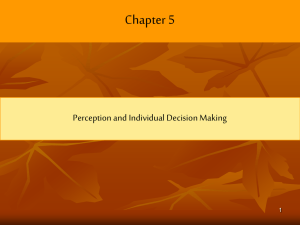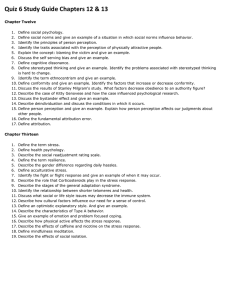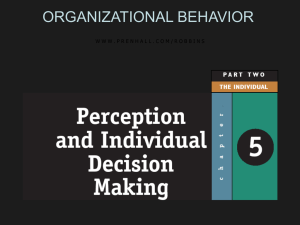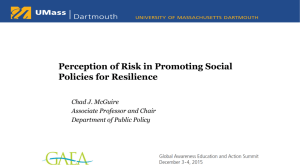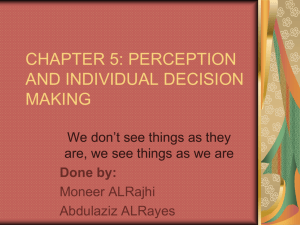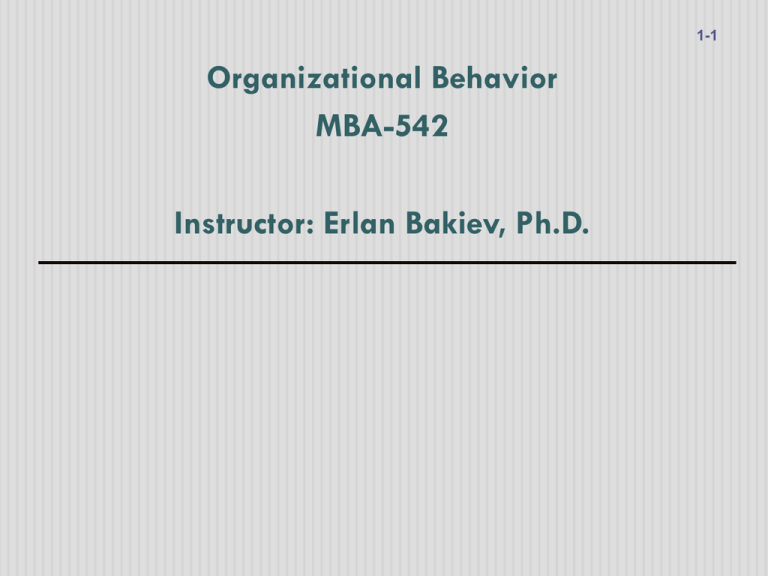
1-1
Organizational Behavior
MBA-542
Instructor: Erlan Bakiev, Ph.D.
5-2
Essentials of
Organizational Behavior, 11/e
Stephen P. Robbins & Timothy A. Judge
Chapter 5
Perception and Individual Decision
Making
After studying this chapter, you should be able to:
5-3
1.
2.
3.
4.
5.
6.
Define perception, and explain the factors that influence it.
Identify the shortcuts individuals use in making judgments
about others.
Explain the link between perception and decision making.
List and explain the common decision biases or errors.
Contrast the three ethical decision criteria.
Define creativity, and discuss the three-component model of
creativity.
Perception
5-4
A process by which individuals
organize and interpret their sensory
impressions in order to give meaning to
their environment.
The world as it is perceived is the
world that is behaviorally important.
Factors Influencing Perception
5-5
Person Perception: Attribution Theory
5-6
Suggests that perceivers try to “attribute” the
observed behavior to a type of cause:
Internal
– behavior is believed to be under the
personal control of the individual
External
– the person is forced into the behavior by
outside events/causes
Determinants of Attribution
5-7
Distinctiveness – whether an individual displays
different behaviors in different situations (the
uniqueness of the act)
Consensus – does everyone who faces a similar situation
respond in the same way as the individual did
Consistency – does the person respond the same way
over time
Determination of Attribution
5-8
5-9
Attribution Errors
Fundamental Attribution Error
The tendency to underestimate the influence of external factors
and overestimate that of internal factors.
Self-Serving Bias
Occurs when individuals overestimate their own (internal)
influence on successes and overestimate the external influences
on their failures.
Shortcuts Used in Judging Others
5-10
Selective Perception – a perceptual filtering process based on
interests, background, and attitude. May allow observers to
draw unwarranted conclusions from an ambiguous situation.
Halo Effect – drawing a general impression based on a single
characteristic.
Contrast Effects – our reaction is influenced by others we have
recently encountered (the context of the observation).
Stereotyping – judging someone on the basis of the perception
of the group to which they belong.
The Link Between Perception and Decision Making
5-11
Decision making occurs as a reaction to a perceived
problem
Perception influences:
Awareness that a problem exists
The interpretation and evaluation of information
Bias of analysis and conclusions
Rational Decision-Making Model
5-12
1.
2.
3.
4.
5.
6.
Define the problem.
Identify the decision criteria.
Allocate weights to the criteria.
Develop the alternatives.
Evaluate the alternatives.
Select the best alternative.
Seldom actually used: more of a goal than a
practical method
Assumptions of the Model
5-13
Complete knowledge of the situation
All relevant options are known in an unbiased
manner
The decision-maker seeks the highest utility
Bounded Rationality
5-14
The limited information-processing capability of human
beings makes it impossible to assimilate and
understand all the information necessary to optimize
So people seek solutions that are satisfactory and
sufficient, rather than optimal (they “satisfice”)
Bounded rationality is constructing simplified models
that extract the essential features from problems
without capturing all their complexity
Decision Making in Bounded Rationality
5-15
Simpler than rational decision making, composed of
three steps:
1.
2.
3.
Limited search for criteria and alternatives – familiar
criteria and easily found alternatives
Limited review of alternatives – focus alternatives,
similar to those already in effect
Satisficing – selecting the first alternative that is “good
enough”
Intuitive Decision Making
5-16
An non-conscious process created
out of distilled experience
Increases with experience
Can be a powerful complement to
rational analysis in decision making
Common Biases and Errors
5-17
Overconfidence Bias
As managers and employees become more knowledgeable
about an issue, the less likely they are to display overconfidence
Anchoring Bias
A tendency to fixate on initial information and fail to
adequately adjust for subsequent information
Confirmation Bias
Seeking out information that reaffirms our past choices and
discounting information that contradicts past judgments
Common Biases and Errors
5-18
Availability Bias
The tendency to base judgments on information that is readily
available
Escalation of Commitment
Staying with a decision even when there is clear evidence that it is
wrong
Risk Aversion
Preferring a sure thing over a risky outcome
Hindsight Bias
The tendency to believe falsely that we could have accurately
predicted the outcome of an event after that outcome is already
known
Organizational Constraints on Decision Making
5-19
Performance evaluations
Reward systems
Formal regulations
Self-imposed time constraints
Historical precedents
Ethical Frameworks for Decision Making
5-20
Utilitarian
Provide the greatest good for the
greatest number
Rights
make decisions consistent with
fundamental liberties and privileges
Justice
impose and enforce rules fairly and
impartially so that there is equal
distribution of benefits and costs
Creativity in Decision Making
5-21
The ability to produce novel and
useful ideas
Helps people to:
Better understand the problem
See problems others can’t see
Identify all viable alternatives
Identify alternatives that aren’t
readily apparent
Three-Component Model of Creativity
5-22
Expertise
CreativeThinking
Skills
Intrinsic
Task
Motivation
Global Implications
5-23
Attributions:
Cross-cultural differences exist – especially in
collectivist traditions
Decision Making:
Cultural background of the decision maker can have
significant influence on decisions made
Ethics:
No global ethical standards exist
Need organizational-level guidance
Implications for Managers
5-24
Perception:
To increase productivity, influence workers’ perceptions of
their jobs
To improve decision making:
1.
2.
3.
4.
5.
Analyze the situation
Adjust your decision approach
Be aware of biases and minimize their impact
Combine rational analysis with intuition
Try to enhance your creativity
Keep in Mind…
5-25
1.
People have inherent biases in perception
and decision making
2.
Biases can be helpful
3.
Understanding those biases allows for better
prediction of behavior
Managers must determine when the bias may be
counterproductive
Creativity aids in decision making
Helps to appraise, understand, and identify problems
Summary
5-26
1. Defined perception and explained the factors that
influence it.
2. Identified the shortcuts individuals use in making
judgments about others.
3. Explained the link between perception and decisionmaking.
4. Listed and explained the common decision biases or
errors.
5. Contrasted the three ethical decision criteria.
6. Defined creativity and discussed the three-component
model of creativity.
5-27
All rights reserved. No part of this publication may be
reproduced, stored in a retrieval system, or transmitted,
in any form or by any means, electronic, mechanical,
photocopying, recording, or otherwise, without the prior
written permission of the publisher. Printed in the
United States of America.

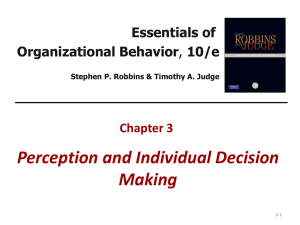
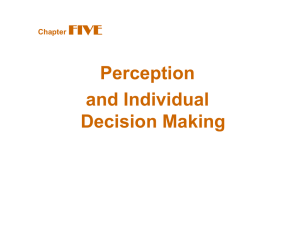
![[SUMMARY] Perilaku Keorganisasian (Chapter 6)](http://s3.studylib.net/store/data/008736782_1-213c4af9e889e5ea17408e8dd491fc35-300x300.png)
